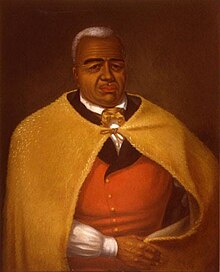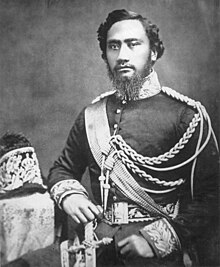Hawaiian Monarchs/Printable version
| This is the print version of Hawaiian Monarchs You won't see this message or any elements not part of the book's content when you print or preview this page. |
The current, editable version of this book is available in Wikibooks, the open-content textbooks collection, at
https://en.wikibooks.org/wiki/Hawaiian_Monarchs
Kamehameha I

Kamehameha I (c. 1758–May 8, 1819), united all the Hawaiian Islands together to form the Kingdom of Hawaii in 1810.
Early Life
[edit | edit source]No one is quite sure exactly what year Kamehameha was born. Hawaiians did not have a written language before the 1800s. Some say Kamehameha was born in 1758 because that is the year Halley’s comet was seen in Hawaii. According to a prophecy, a fiery light in the sky would come before the birth of a “killer of chiefs”. Alapa’i, the chief of the island of Hawai’i, heard about this prophecy and ordered the baby Kamehameha to be killed. Kamehameha’s parents, Chief Keōua and Chiefess Kekuʻiapoiwa, secretly gave him to a trusted friend Nae’ole to take care of him and keep him safe from Chief Alapa’i. Five years later, Chief Alapa’i decided that maybe Kamehameha would not kill him and invited him back to live with his family.
Unifying the Islands
[edit | edit source]When Kamehameha was 14, he overturned the Naha Stone. According to legend, only someone from the royal Naha family could move the stone. Whoever lifted the Naha Stone, would be the one to unite all of the Hawaiian Islands. Even though Kamehameha was not from the Naha family, he lifted and overturned the stone. Today, you can see the Naha Stone in front of the Hilo Public Library. From 1782 until 1810, Kamehameha fought many battles to conquer each of the Hawaiian islands. First, he defeated his cousin Kiwala’o and Chief Keawemaʻuhili who ruled the island of Hawai’i. Next, he defeated Chief Kalanikupule who ruled Maui and ‘Oahu. Kamehameha tried several times to attack Chief Kaumualiʻi of Kauai but was unsuccessful. Chief Kaumuali’i seeing there was no way to stop Kamehameha’s powerful army, offered to surrender Kauai and Ni’ihau.
Wives and Children
[edit | edit source]King Kamehameha had many wives. His favorite wife was Kaahumanu. Kaahumanu had no children of her own but she hanai adopted Kamehameha’s son Liholiho. Kaahumanu was a strong political figure and even when Liholiho became King Kamehameha II she became his regent. A regent is someone who rules for someone else who is too young to rule. Keōpūolani was Kamehameha’s highest ranking wife. She had at least three children. Liholiho and Kauikeaouli were her sons. They would become Kamehameha II and Kamehameha III. Nāhiʻenaʻena was her daughter. Her other children died when they were very young.
Death
[edit | edit source]Kamehameha died on May 8, 1819. Following Hawaiian customs, his bones were hidden by two of his most trusted friends. Even today no one knows where his body was buried.
After Kamehameha died, Liholiho became King Kamehameha II.
See Also
[edit | edit source]References
[edit | edit source]- Wong and Rayson (1987). Hawaii's Royal History. Bess Press. ISBN 0935848487
Links
[edit | edit source]
Kamehameha II

Sandalwood Trade
[edit | edit source]
The sandalwood trade was started by Kamehameha I. The people that wanted to trade were the Chinese and later the English. They traded fur, tea, rum, cocoa, guns, ammo, yams, cottons, woolens, nails, saddles, canvases, French wines, glass, harnesses, iron pots, pans, pens, paper, ink, flour, soap, rice, hemp, and animals such as goats and pigs. The sandalwood trade ended when Kamehameha I died. The sandalwood trade started up again by Kamehameha II but with lesser control. The sandalwood trade became so popular that there was less and less sandalwood. Kamehameha II ordered his people to find more sandalwood. There was so little sandalwood that Kamehameha II promised to send sandalwood to his traders. More and more foreign people came to Hawaii and brought diseases that killed a lot of his people. Kamehameha II wrote a letter to King George (King Of England) to ask for help , and that is when the sandalwood trade ended.
Liholiho Death
[edit | edit source]Liholiho and Kamamalu both were going on a trip to visit George IV. The couple were going to England on the British ship. Liholiho and Kamamalu left Hawai’i on the year of 1823. While Liholiho went to England, his brother Kauikeaouli ruled the land while he was gone. It took Liholiho and Kamamalu 6 months to reach England. When Liholiho and Kamamalu arrived to England, they stayed at a London hotel. Liholiho and Kamamalu got to watch a theater performance and a balloon ascent. A month later, Kamamalu died on July 8, 1824 and Liholiho died a week later, both of them died from measles. The English people shipped the bodies back to Hawai’i. When the Hawaiian people found out that their king died every one was very sad. The next King Kamehameha III Kauikeaouli was the third child of Kamehameha.
Kamehameha III

Kamehameha III drasticly changed the government of Hawaii.[1]
References
[edit | edit source]- ↑ "Kauikeaouli (Kamehameha III)". Punahou School. 2 September 2020. Retrieved 30 October 2021.
| This page or section is an undeveloped draft or outline. You can help to develop the work, or you can ask for assistance in the project room. |
Kamehameha IV

When Kamehameha IV died young, a power struggle ensured.[1]
| This page or section is an undeveloped draft or outline. You can help to develop the work, or you can ask for assistance in the project room. |
References
[edit | edit source]- ↑ "Novemaba 30: Ka Make ʻana o Kamehameha IV – Punawaiola". blog.hawaii.edu. Retrieved 30 October 2021.
Kamehameha V

Established Kamehameha day.[1]
| This page or section is an undeveloped draft or outline. You can help to develop the work, or you can ask for assistance in the project room. |
References
[edit | edit source]- ↑ "Kamehameha Day is steeped in history". www.ksbe.edu. Retrieved 30 October 2021.
William Lunalilo

| This page or section is an undeveloped draft or outline. You can help to develop the work, or you can ask for assistance in the project room. |
References
[edit | edit source]